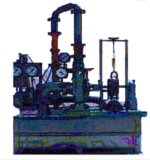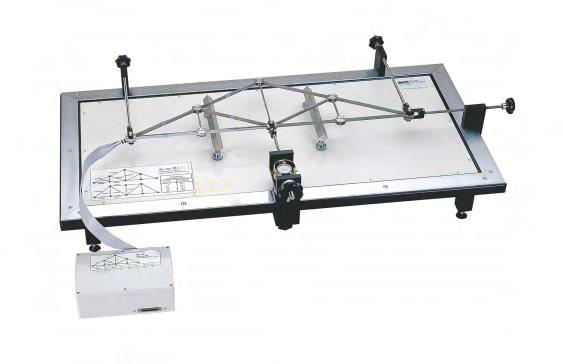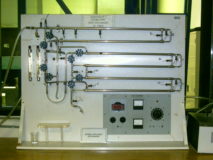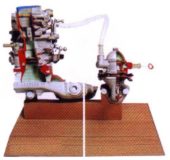FORCES IN A HOWE TRUSS Model MT 110
Home » Products » FORCES IN A HOWE TRUSS Model MT 110
FORCES IN A HOWE TRUSS Model MT 110
As light-weight structures offering a high degree of rigidity, trusses are employed in the construction of halls, bridges, cranes, pylons and masts. Trusses are bar structures in which the bars are subjected to compression or tension loading, but not to bending. Sci-tech Forces in a Howe Truss Model MT 110 setup provides experiments on single plane trusses with a high degree of measuring accuracy and computerized result readout based on software. The ready assembled truss is mounted horizontally on a frame. The influence of the dead weight is minimized by horizontal experimental setup. The bars are joined by a “hinged” connection, using node disks. Consequently, our truss can be considered as an ideal truss. The external force is generated with the aid of a threaded spindle. The force can be applied in various directions and at various points. The forces occurring on the truss bars are recorded by strain gauge measurement. All measuring points are housed together in a connection box. From there, they are connected to the measuring amplifier FL 152. The software is used to manage the measuring data and provide graphical representation of the bar forces. The software features a comprehensive help function. An additional truss is available to extend the scope of the experiment: Warren type.
| Size: | 110cm x 50cm x 35cm (LxWxH) |
| Weight: | 15 kg |
Item Description
As light-weight structures offering a high degree of rigidity, trusses are employed in the construction of halls, bridges, cranes, pylons and masts. Trusses are bar structures in which the bars are subjected to compression or tension loading, but not to bending.
Sci-tech Forces in a Howe Truss Model MT 110 setup provides experiments on single plane trusses with a high degree of measuring accuracy and computerized result readout based on software. The ready assembled truss is mounted horizontally on a frame. The influence of the dead weight is minimized by horizontal experimental setup. The bars are joined by a “hinged” connection, using node disks. Consequently, our truss can be considered as an ideal truss. The external force is generated with the aid of a threaded spindle. The force can be applied in various directions and at various points.
The forces occurring on the truss bars are recorded by strain gauge measurement. All measuring points are housed together in a connection box. From there, they are connected to the measuring amplifier FL 152. The software is used to manage the measuring data and provide graphical representation of the bar forces. The software features a comprehensive help function.
An additional truss is available to extend the scope of the experiment: Warren type.
Technical Specifications
Specifications
- Investigation of bar forces in a single plane, statically determinate truss
- Ready assembled Howe truss
- Frame for horizontal experimental setup
- Influence of dead weight minimized by horizontal experimental setup
- Any straight and inclined load cases possible
- Fine adjustment of load force
- Low-friction knife-edge bearing
- 2 supports for vertical forces, 1 support for horizontal forces
- Pre-balanced strain gauge connection box with connection to measuring amplifier.
- Measuring amplifier required
- ‘Sci-Cal’ Sci-tech-software optional to evaluate measured values graphically.
Technical Specifications
Truss: Howe type
- bar cross-section: 10x3mm, stainless steel
- bar lengths: 115,5, 200, 231mm
- external loading: max. 500N
- bars: 13, of which 7 with measuring points
Load application device with force gauge
- tensile force: max. 600N
- stroke: 30mm
Node disks: 8
Angle between bars: 30°, 45°
Experiments
- Measurement of the bar forces in a single plane truss, Howe type
- Dependency of bar forces on the external force: magnitude, direction, point of application.
- Comparison of measuring results with mathematical and graphical methods
- method of joints
- Ritter’s method of sections
- Cremona diagram
- Basic principle: measurement of forces using strain gauge measurement.
Model Number
MT 110
See also different:

Sci-tech Francis Turbine Operating Principles Model FM 96 is the model of a Francis turbine demonstrating the function of a reaction turbine.



